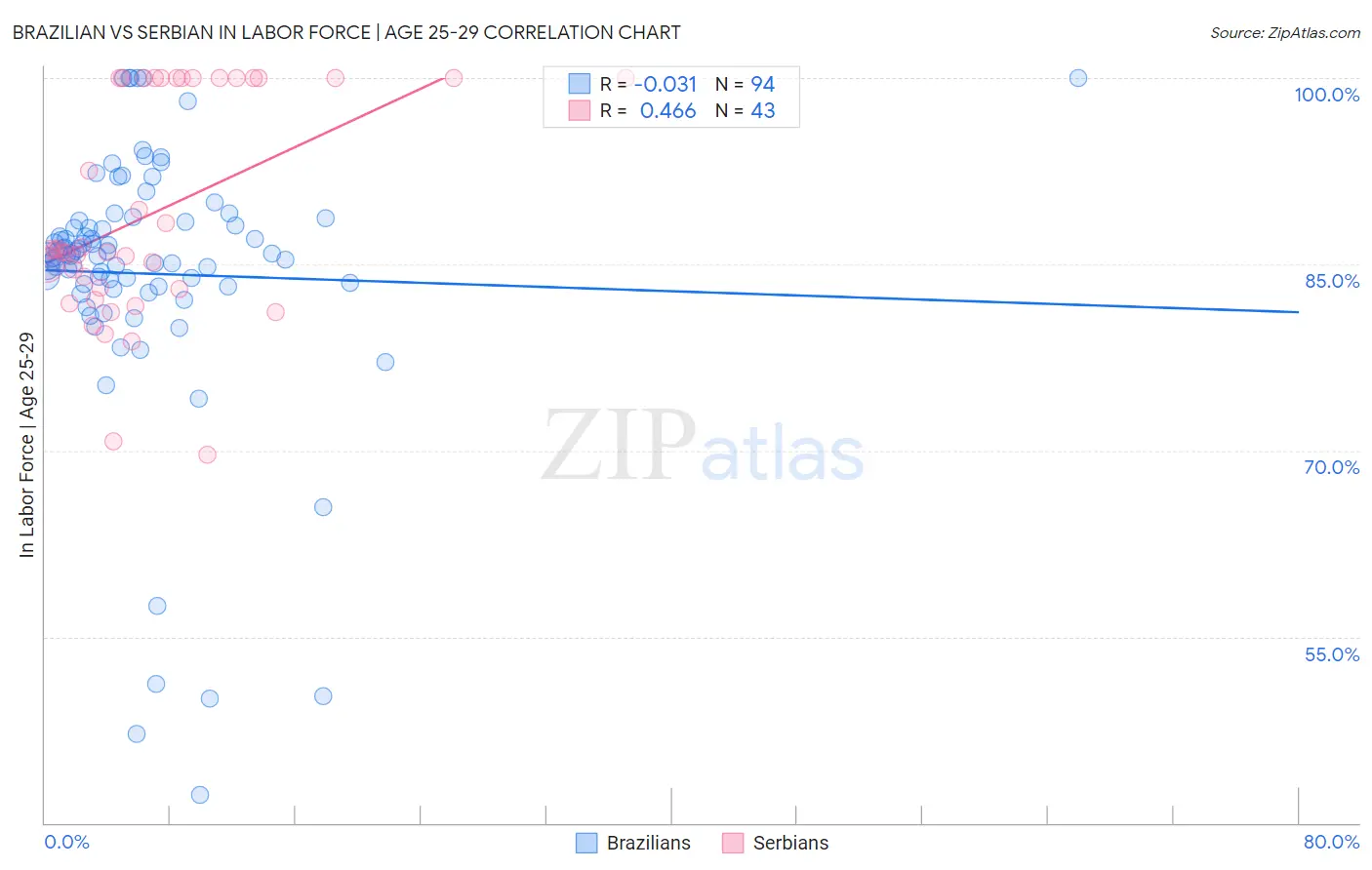Brazilian vs Serbian In Labor Force | Age 25-29
COMPARE
Brazilian
Serbian
In Labor Force | Age 25-29
In Labor Force | Age 25-29 Comparison
Brazilians
Serbians
85.3%
IN LABOR FORCE | AGE 25-29
98.3/ 100
METRIC RATING
75th/ 347
METRIC RANK
85.5%
IN LABOR FORCE | AGE 25-29
99.5/ 100
METRIC RATING
61st/ 347
METRIC RANK
Brazilian vs Serbian In Labor Force | Age 25-29 Correlation Chart
The statistical analysis conducted on geographies consisting of 323,871,107 people shows no correlation between the proportion of Brazilians and labor force participation rate among population between the ages 25 and 29 in the United States with a correlation coefficient (R) of -0.031 and weighted average of 85.3%. Similarly, the statistical analysis conducted on geographies consisting of 267,583,292 people shows a moderate positive correlation between the proportion of Serbians and labor force participation rate among population between the ages 25 and 29 in the United States with a correlation coefficient (R) of 0.466 and weighted average of 85.5%, a difference of 0.21%.

In Labor Force | Age 25-29 Correlation Summary
| Measurement | Brazilian | Serbian |
| Minimum | 42.3% | 69.7% |
| Maximum | 100.0% | 100.0% |
| Range | 57.7% | 30.3% |
| Mean | 84.2% | 89.2% |
| Median | 85.8% | 86.2% |
| Interquartile 25% (IQ1) | 83.2% | 83.0% |
| Interquartile 75% (IQ3) | 88.4% | 100.0% |
| Interquartile Range (IQR) | 5.2% | 17.0% |
| Standard Deviation (Sample) | 10.8% | 8.9% |
| Standard Deviation (Population) | 10.7% | 8.8% |
Demographics Similar to Brazilians and Serbians by In Labor Force | Age 25-29
In terms of in labor force | age 25-29, the demographic groups most similar to Brazilians are German (85.3%, a difference of 0.020%), Soviet Union (85.3%, a difference of 0.030%), Immigrants from South Central Asia (85.2%, a difference of 0.040%), Immigrants from Egypt (85.2%, a difference of 0.060%), and Russian (85.3%, a difference of 0.070%). Similarly, the demographic groups most similar to Serbians are Thai (85.5%, a difference of 0.0%), Taiwanese (85.4%, a difference of 0.020%), Immigrants from Kenya (85.4%, a difference of 0.020%), Immigrants from Morocco (85.5%, a difference of 0.030%), and Greek (85.5%, a difference of 0.040%).
| Demographics | Rating | Rank | In Labor Force | Age 25-29 |
| Greeks | 99.6 /100 | #58 | Exceptional 85.5% |
| Immigrants | Morocco | 99.5 /100 | #59 | Exceptional 85.5% |
| Thais | 99.5 /100 | #60 | Exceptional 85.5% |
| Serbians | 99.5 /100 | #61 | Exceptional 85.5% |
| Taiwanese | 99.4 /100 | #62 | Exceptional 85.4% |
| Immigrants | Kenya | 99.4 /100 | #63 | Exceptional 85.4% |
| Immigrants | Italy | 99.3 /100 | #64 | Exceptional 85.4% |
| Immigrants | Czechoslovakia | 99.3 /100 | #65 | Exceptional 85.4% |
| Immigrants | Scotland | 99.3 /100 | #66 | Exceptional 85.4% |
| Immigrants | Turkey | 99.2 /100 | #67 | Exceptional 85.4% |
| Immigrants | Cameroon | 99.2 /100 | #68 | Exceptional 85.4% |
| Menominee | 99.1 /100 | #69 | Exceptional 85.4% |
| Immigrants | Sweden | 99.1 /100 | #70 | Exceptional 85.4% |
| Kenyans | 99.0 /100 | #71 | Exceptional 85.4% |
| Immigrants | Australia | 98.9 /100 | #72 | Exceptional 85.3% |
| Russians | 98.8 /100 | #73 | Exceptional 85.3% |
| Soviet Union | 98.5 /100 | #74 | Exceptional 85.3% |
| Brazilians | 98.3 /100 | #75 | Exceptional 85.3% |
| Germans | 98.1 /100 | #76 | Exceptional 85.3% |
| Immigrants | South Central Asia | 97.9 /100 | #77 | Exceptional 85.2% |
| Immigrants | Egypt | 97.7 /100 | #78 | Exceptional 85.2% |